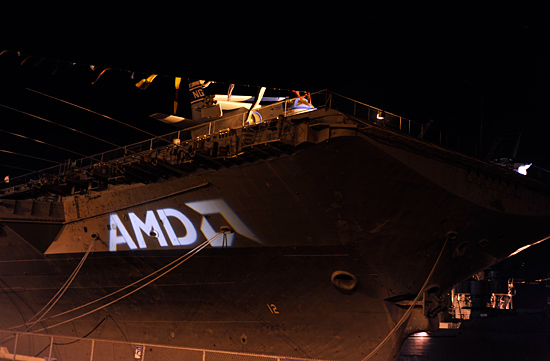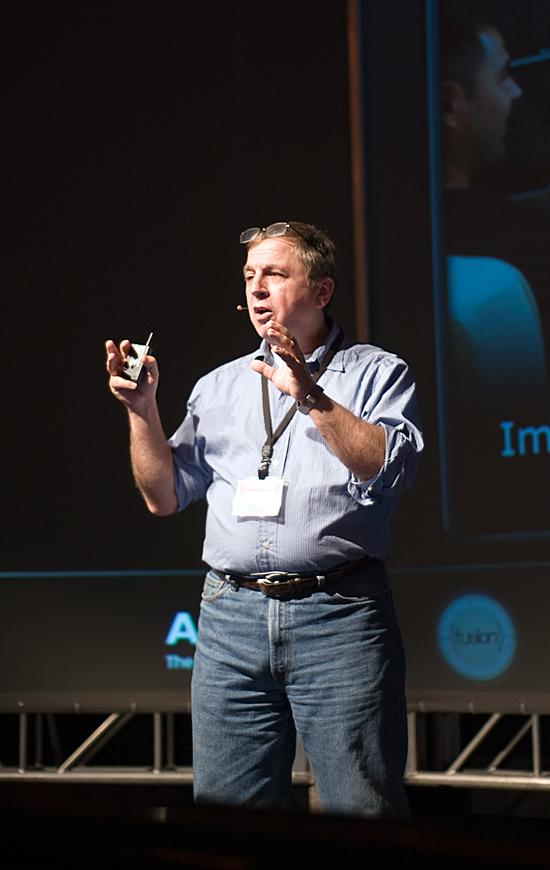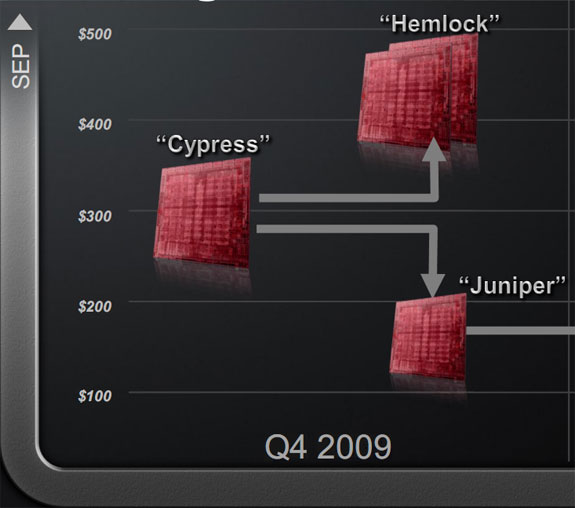The RV870 Story: AMD Showing up to the Fight
by Anand Lal Shimpi on February 14, 2010 12:00 AM EST- Posted in
- GPUs
The Call
My love/hate relationship with AMD PR continued last year. But lately, it’s been far less hate. Let’s rewind back to the Summer of 2009. I’d been waiting for AMD to call for weeks.
We all knew that the RV870 was going to launch sometime before the end of the year, and we’re normally briefed on new GPUs around a month or so before we get hardware. The rumors said that the launch had been pushed back, but just like clockwork I got a call in June or July of last year. It was my old friend, Chris Hook of AMD PR.

This time he wanted me to come to a press event on a carrier off the coast of California. Sigh.
It’s not that I have anything against carriers. It’s just that all I cared about at that time was the long awaited successor to the RV770. The RV770 was the GPU that unequivocally restored my faith in ATI graphics, an impact shared by others last June. But that’s not how the game is played I’m afraid. AMD promises its management and its partners that they can fill a room (or carrier) up with important press. We get promised access to engineers, useful information and free drinks.

The USS Hornet. GPUs are in there.
I’m not easily swayed by free drinks, but Chris Hook knows me well enough by now to know what I’d appreciate even more.
The Dinner - September 2009
I had to leave dinner earlier than I wanted to. ASUS’ Chairman Jonney Shih was in town and only had one opportunity to meet me before I left Oakland. Whenever either of us happens to be in the same town, we always make our best effort to meet - and I wasn’t going to let him down. In the same vein that Steve Jobs is successful because he is a product guy at heart, running a company best known for its products. Jonney Shih is an engineer at heart, and he runs a company who has always been known for their excellence in engineering. This wasn’t just another meeting with an executive, this was a meeting with someone who has a passion for the same things I do. His focus isn’t on making money, it’s on engineering. It’s a rare treat.
My ride was waiting outside. I closed the lid on my laptop, making sure to save the 13 pages of notes I just took while at dinner. And I shook this man’s hand:

Before I left he asked me to do one thing. He said “Try not to make the story about me. There are tons of hardworking engineers that really made this chip happen”. Like Jonney, Carrell Killebrew has his own combination of traits that make him completely unique in this industry. All of the greats are like that. They’ve all got their own history that brought them to the companies that they work for today, and they have their own sets of personality traits that when combined make them so unique. For Carrell Killebrew it's a mixture of intelligence, pragmatism, passion and humility that's very rare to see. He's also a genuinely good guy. One of his tenets is that you should always expect the best from others. If you expect any less than the best, that’s all you’ll ever get from them. It’s a positive take on people, one that surprisingly enough only burned Carrell once. Perhaps he’s more fortunate than most.
Mr. Killebrew didn’t make the RV870, but he was beyond instrumental in making sure it was a success. What follows is a small portion of the story of the RV870, the GPU behind the Radeon HD 5800 series. I call it a small portion of the story because despite this article using more than eight thousand words to tell it, the actual story took place over years and in the minds and work of hundreds of engineers. This GPU, like all others (even Fermi) is the lifework of some of the best engineers in the industry. They are the heroes of our industry, and I hope I can do their story justice.
As is usually the case with these GPU backstories, to understand why things unfolded the way they did we have to look back a few years. Introducing a brand new GPU can take 2 - 4 years from start to finish. Thus to understand the origins of the Radeon HD 5800 series (RV870) we have to look back to 2005.
Sidebar on Naming
AMD PR really doesn’t like it when I use the name RV870. With this last generation of GPUs, AMD wanted to move away from its traditional naming. According to AMD, there is no GPU called the RV870, despite the fact that Carrell Killebrew, Eric Demers and numerous others referred to it as such over the past couple of years. As with most drastic changes, it usually takes a while for these things to sink in. I’ve also heard reference to an RV870 jar - think of it as a swear jar but for each time someone calls Cypress an RV870.

Why the change? Well, giving each member of a GPU family a name helps confuse the competition. It’s easy to know that RV870 is the successor to the RV770. It’s harder to tell exactly what a Cypress is.
AMD PR would rather me refer to RV870 and the subject of today’s story as Cypress. The chart below shows AMD’s full listing of codenames for the 40nm DX11 GPU lineup:
| GPU | Codename |
| ATI Radeon HD 5900 Series | Hemlock |
| ATI Radeon HD 5800 Series | Cypress |
| ATI Radeon HD 5700 Series | Juniper |
| ATI Radeon HD 5600/5500 Series | Redwood |
| ATI Radeon HD 5400 Series | Cedar |
Given that we still haven’t purged the RVxxx naming from our vocabulary, I’m going to stick with RV870 for this story. But for those of you who have embraced the new nomenclature - RV870 = Cypress and at points I will use the two names interchangeably. The entire chip stack is called Evergreen. The replacement stack is called the Northern Islands.










132 Comments
View All Comments
Stas - Sunday, February 14, 2010 - link
Awesome. Thanks!Adul - Sunday, February 14, 2010 - link
Really helps pass the time at work today. :) Keep it up.Btw when can we expect to see the new site launch?
aapocketz - Sunday, February 14, 2010 - link
[quote]I was convinced that ATI had embraced a new, refocused approach to GPU design, only to learn that they nearly threw out all of the learnings with the RV870. [/quote]It sounds like they have had some successes trying different techniques, but without stability in their production process it is hard to repeat success. I understand that they require constant innovation to stay competitive, but throwing out whole processes seems chaotic to me. I would like them to refine and improve successful processes rather than toss everything every time a new business guru is in charge.
Also half of their effort was all about openness and collaboration. The opening up of the PRS document so that "everyone was involved in the process" seems to clash with the hyper-secret groups where "AMD has since incorporated much of Carrell’s brand of information compartmentalization into how it handled other upcoming features." This seems like a recipe for disaster to me. Which is it, broad openness, collaboration and consesus; or secret teams that have no idea what the other teams are doing?
SuperGee - Sunday, February 14, 2010 - link
The story told us that they didn't know it will become a succes because these desision where made before RV770 release. So doing the high risk choice again. Wasn't a nobrainer. But a risky choice. We know that it turn out good now.mckirkus - Sunday, February 14, 2010 - link
It's kind of funny that you're not yet running one of these companies yet Anand.One of the reasons I check this site on a daily basis is because you also seem to also get the business side of the equation. It's downright refreshing to see someone bridging that gap. You pretty much saved the Vertex from self destruction. I'd like to see what interesting things you could build us if you put your mind to it.
deputc26 - Sunday, February 14, 2010 - link
Articles like these are what differentiate AnandTech from all the other sites out there. AnandTech goes from being one of the best review sites out there to something special.Beyond excellent, thanks Anand.
rickyv - Sunday, February 14, 2010 - link
As a loyal follower of your website for the past 15 years, I also felt that I just had to register and compliment you on an excellent article.With the rapid advancement of technology, it is very easy just to get caught up in the PR and marketing hype or focus only on the numbers game. We often lose sight of the fact that it is teams of dedicated people who make this possible. You have always had the ability to bring out the "human" side to this. I have not seen this on any other site nor in printed form (that is not an unashamedly PR marketing exercise).
Thanks for staying true to your roots by giving honest opinions of the technology that you review. The latest releases are not necessarily always the greatest (as much as the marketing departments would like us to believe :-) )
krish123 - Sunday, February 14, 2010 - link
After i read the article, I found that "Engine is running well and firing on all the cylinders", It can create better products in the future, I can trust and buy ATI products, hope they deliver better products in the future for my upgrade."Kudos to Anand for the excellent article".
By the way graphics card is a product, not just hardware, it has to work in tandem with the software, its better ATI put some more effort on the driver/software side and fix all the issues.
Krish
smartalec - Sunday, February 14, 2010 - link
"When companies like AMD and NVIDIA do a product the engineers don't know all of the answers, and the knowledge they do have isn't binary - it's probability, it's weight, it's guesses. Sometimes they guess right, and sometimes they guess very wrong. The best they can do is to all weigh in with their individual experiences and together come up with the best group of guesses to implement."I'm afraid this is how all engineering works. Project managers think that engineers can predict the future. That we know exactly how much time it'll take, and how much risk a given feature will bring.
We don't. There's a lot of educated guesses. Sometimes we're pleasantly surprised that what we thought was a tough problem wasn't. Sometimes we're the bearer of bad news-- something we assumed would be trivial wasn't.
My most frustrating issues aren't technical at all. I ask for 2000 hours, and are given 1000. Or are given 2 engineers instead of 3, and told-- figure out a way to get it done anyway, without impacting schedule.
Great article Anand.
mckirkus - Sunday, February 14, 2010 - link
Any decent project manager (I do software) reviews the risks up front with the engineers before building the project plan / timeline.The fact that most project managers don't really understand the products they manage is the rule not the exception. The problem is that great engineers don't always make great PMs. Having a good tech lead helps.